Wireless Networks and Communications Assignment
VerifiedAdded on 2023/06/10
|9
|1961
|237
AI Summary
This assignment covers the selection of a suitable frequency band for WSN, calculation of channel capacity, noise levels, signal power, cloud application, and IoT platforms for the implementation of WSN.
Contribute Materials
Your contribution can guide someone’s learning journey. Share your
documents today.
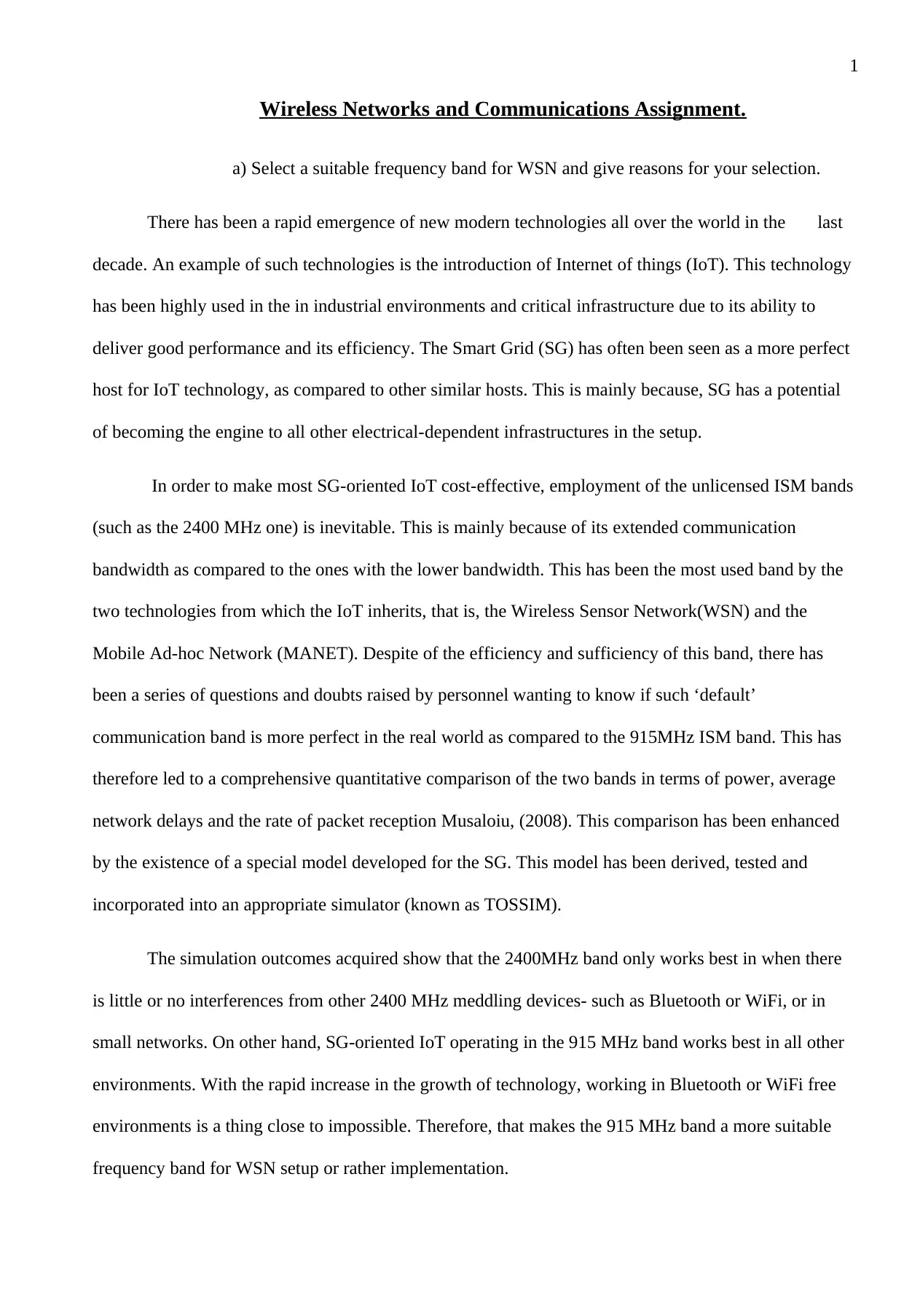
1
Wireless Networks and Communications Assignment.
a) Select a suitable frequency band for WSN and give reasons for your selection.
There has been a rapid emergence of new modern technologies all over the world in the last
decade. An example of such technologies is the introduction of Internet of things (IoT). This technology
has been highly used in the in industrial environments and critical infrastructure due to its ability to
deliver good performance and its efficiency. The Smart Grid (SG) has often been seen as a more perfect
host for IoT technology, as compared to other similar hosts. This is mainly because, SG has a potential
of becoming the engine to all other electrical-dependent infrastructures in the setup.
In order to make most SG-oriented IoT cost-effective, employment of the unlicensed ISM bands
(such as the 2400 MHz one) is inevitable. This is mainly because of its extended communication
bandwidth as compared to the ones with the lower bandwidth. This has been the most used band by the
two technologies from which the IoT inherits, that is, the Wireless Sensor Network(WSN) and the
Mobile Ad-hoc Network (MANET). Despite of the efficiency and sufficiency of this band, there has
been a series of questions and doubts raised by personnel wanting to know if such ‘default’
communication band is more perfect in the real world as compared to the 915MHz ISM band. This has
therefore led to a comprehensive quantitative comparison of the two bands in terms of power, average
network delays and the rate of packet reception Musaloiu, (2008). This comparison has been enhanced
by the existence of a special model developed for the SG. This model has been derived, tested and
incorporated into an appropriate simulator (known as TOSSIM).
The simulation outcomes acquired show that the 2400MHz band only works best in when there
is little or no interferences from other 2400 MHz meddling devices- such as Bluetooth or WiFi, or in
small networks. On other hand, SG-oriented IoT operating in the 915 MHz band works best in all other
environments. With the rapid increase in the growth of technology, working in Bluetooth or WiFi free
environments is a thing close to impossible. Therefore, that makes the 915 MHz band a more suitable
frequency band for WSN setup or rather implementation.
Wireless Networks and Communications Assignment.
a) Select a suitable frequency band for WSN and give reasons for your selection.
There has been a rapid emergence of new modern technologies all over the world in the last
decade. An example of such technologies is the introduction of Internet of things (IoT). This technology
has been highly used in the in industrial environments and critical infrastructure due to its ability to
deliver good performance and its efficiency. The Smart Grid (SG) has often been seen as a more perfect
host for IoT technology, as compared to other similar hosts. This is mainly because, SG has a potential
of becoming the engine to all other electrical-dependent infrastructures in the setup.
In order to make most SG-oriented IoT cost-effective, employment of the unlicensed ISM bands
(such as the 2400 MHz one) is inevitable. This is mainly because of its extended communication
bandwidth as compared to the ones with the lower bandwidth. This has been the most used band by the
two technologies from which the IoT inherits, that is, the Wireless Sensor Network(WSN) and the
Mobile Ad-hoc Network (MANET). Despite of the efficiency and sufficiency of this band, there has
been a series of questions and doubts raised by personnel wanting to know if such ‘default’
communication band is more perfect in the real world as compared to the 915MHz ISM band. This has
therefore led to a comprehensive quantitative comparison of the two bands in terms of power, average
network delays and the rate of packet reception Musaloiu, (2008). This comparison has been enhanced
by the existence of a special model developed for the SG. This model has been derived, tested and
incorporated into an appropriate simulator (known as TOSSIM).
The simulation outcomes acquired show that the 2400MHz band only works best in when there
is little or no interferences from other 2400 MHz meddling devices- such as Bluetooth or WiFi, or in
small networks. On other hand, SG-oriented IoT operating in the 915 MHz band works best in all other
environments. With the rapid increase in the growth of technology, working in Bluetooth or WiFi free
environments is a thing close to impossible. Therefore, that makes the 915 MHz band a more suitable
frequency band for WSN setup or rather implementation.
Secure Best Marks with AI Grader
Need help grading? Try our AI Grader for instant feedback on your assignments.
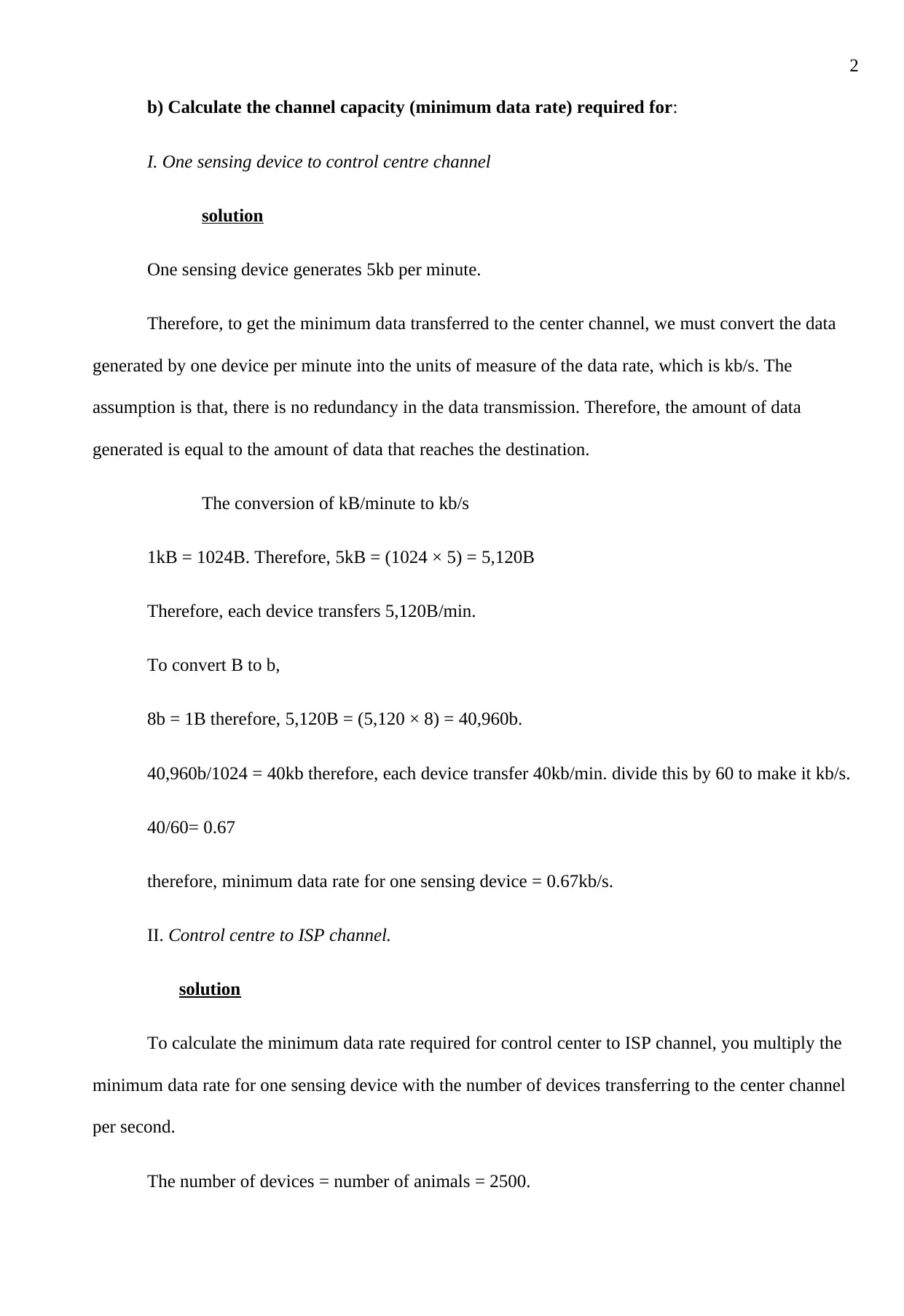
2
b) Calculate the channel capacity (minimum data rate) required for:
I. One sensing device to control centre channel
solution
One sensing device generates 5kb per minute.
Therefore, to get the minimum data transferred to the center channel, we must convert the data
generated by one device per minute into the units of measure of the data rate, which is kb/s. The
assumption is that, there is no redundancy in the data transmission. Therefore, the amount of data
generated is equal to the amount of data that reaches the destination.
The conversion of kB/minute to kb/s
1kB = 1024B. Therefore, 5kB = (1024 × 5) = 5,120B
Therefore, each device transfers 5,120B/min.
To convert B to b,
8b = 1B therefore, 5,120B = (5,120 × 8) = 40,960b.
40,960b/1024 = 40kb therefore, each device transfer 40kb/min. divide this by 60 to make it kb/s.
40/60= 0.67
therefore, minimum data rate for one sensing device = 0.67kb/s.
II. Control centre to ISP channel.
solution
To calculate the minimum data rate required for control center to ISP channel, you multiply the
minimum data rate for one sensing device with the number of devices transferring to the center channel
per second.
The number of devices = number of animals = 2500.
b) Calculate the channel capacity (minimum data rate) required for:
I. One sensing device to control centre channel
solution
One sensing device generates 5kb per minute.
Therefore, to get the minimum data transferred to the center channel, we must convert the data
generated by one device per minute into the units of measure of the data rate, which is kb/s. The
assumption is that, there is no redundancy in the data transmission. Therefore, the amount of data
generated is equal to the amount of data that reaches the destination.
The conversion of kB/minute to kb/s
1kB = 1024B. Therefore, 5kB = (1024 × 5) = 5,120B
Therefore, each device transfers 5,120B/min.
To convert B to b,
8b = 1B therefore, 5,120B = (5,120 × 8) = 40,960b.
40,960b/1024 = 40kb therefore, each device transfer 40kb/min. divide this by 60 to make it kb/s.
40/60= 0.67
therefore, minimum data rate for one sensing device = 0.67kb/s.
II. Control centre to ISP channel.
solution
To calculate the minimum data rate required for control center to ISP channel, you multiply the
minimum data rate for one sensing device with the number of devices transferring to the center channel
per second.
The number of devices = number of animals = 2500.
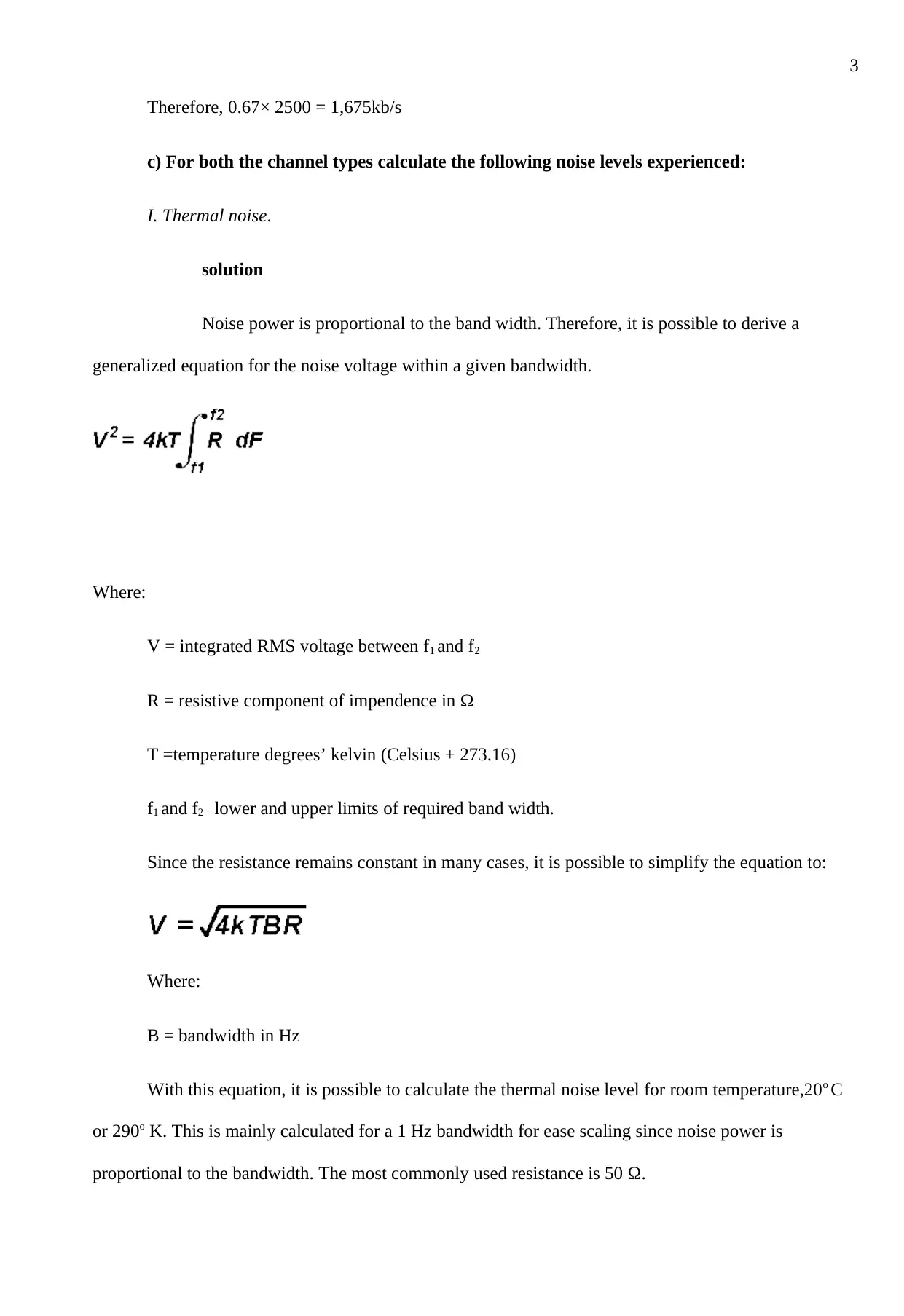
3
Therefore, 0.67× 2500 = 1,675kb/s
c) For both the channel types calculate the following noise levels experienced:
I. Thermal noise.
solution
Noise power is proportional to the band width. Therefore, it is possible to derive a
generalized equation for the noise voltage within a given bandwidth.
Where:
V = integrated RMS voltage between f1 and f2
R = resistive component of impendence in Ω
T =temperature degrees’ kelvin (Celsius + 273.16)
f1 and f2 = lower and upper limits of required band width.
Since the resistance remains constant in many cases, it is possible to simplify the equation to:
Where:
B = bandwidth in Hz
With this equation, it is possible to calculate the thermal noise level for room temperature,20o C
or 290o K. This is mainly calculated for a 1 Hz bandwidth for ease scaling since noise power is
proportional to the bandwidth. The most commonly used resistance is 50 Ω.
Therefore, 0.67× 2500 = 1,675kb/s
c) For both the channel types calculate the following noise levels experienced:
I. Thermal noise.
solution
Noise power is proportional to the band width. Therefore, it is possible to derive a
generalized equation for the noise voltage within a given bandwidth.
Where:
V = integrated RMS voltage between f1 and f2
R = resistive component of impendence in Ω
T =temperature degrees’ kelvin (Celsius + 273.16)
f1 and f2 = lower and upper limits of required band width.
Since the resistance remains constant in many cases, it is possible to simplify the equation to:
Where:
B = bandwidth in Hz
With this equation, it is possible to calculate the thermal noise level for room temperature,20o C
or 290o K. This is mainly calculated for a 1 Hz bandwidth for ease scaling since noise power is
proportional to the bandwidth. The most commonly used resistance is 50 Ω.

4
since the thermal noise in a 50 Ω system at room temperature is -174dB/Hz (from the equation P
= V2/4R), the expression, 9nV = -174 dB/Hz counts. Thus,
the thermal noise at 20 oC = -174dB/Hz.
II. Total noise experienced.
From the case study given, the thermal noise contributes to only 5% of the total noise
experienced.
Therefore,
if -174dB/Hz = 5% then, 100% = (-174×100) / 5 = -3,480 dB/Hz
d) It is expected to maintain SNR of 63 at the control centre for sensor signals.
I. Calculate the signal power received at control centre from one sensing device.
From the question, signal power divided by noise power gives 63.
Therefore, S/N = 63. But the total noise = -3480 dB/Hz.
Therefore, S/-3480=63.
Thus, the total signal power S = -3480 dB/Hz × 63 = - 219,240 db/Hz.
To get the signal power for one sensing device, divide the total signal power by the number of
devices present.
That is, (-219,240dB/Hz)/ 2500 = -87.696 dB/Hz
since the thermal noise in a 50 Ω system at room temperature is -174dB/Hz (from the equation P
= V2/4R), the expression, 9nV = -174 dB/Hz counts. Thus,
the thermal noise at 20 oC = -174dB/Hz.
II. Total noise experienced.
From the case study given, the thermal noise contributes to only 5% of the total noise
experienced.
Therefore,
if -174dB/Hz = 5% then, 100% = (-174×100) / 5 = -3,480 dB/Hz
d) It is expected to maintain SNR of 63 at the control centre for sensor signals.
I. Calculate the signal power received at control centre from one sensing device.
From the question, signal power divided by noise power gives 63.
Therefore, S/N = 63. But the total noise = -3480 dB/Hz.
Therefore, S/-3480=63.
Thus, the total signal power S = -3480 dB/Hz × 63 = - 219,240 db/Hz.
To get the signal power for one sensing device, divide the total signal power by the number of
devices present.
That is, (-219,240dB/Hz)/ 2500 = -87.696 dB/Hz
Secure Best Marks with AI Grader
Need help grading? Try our AI Grader for instant feedback on your assignments.
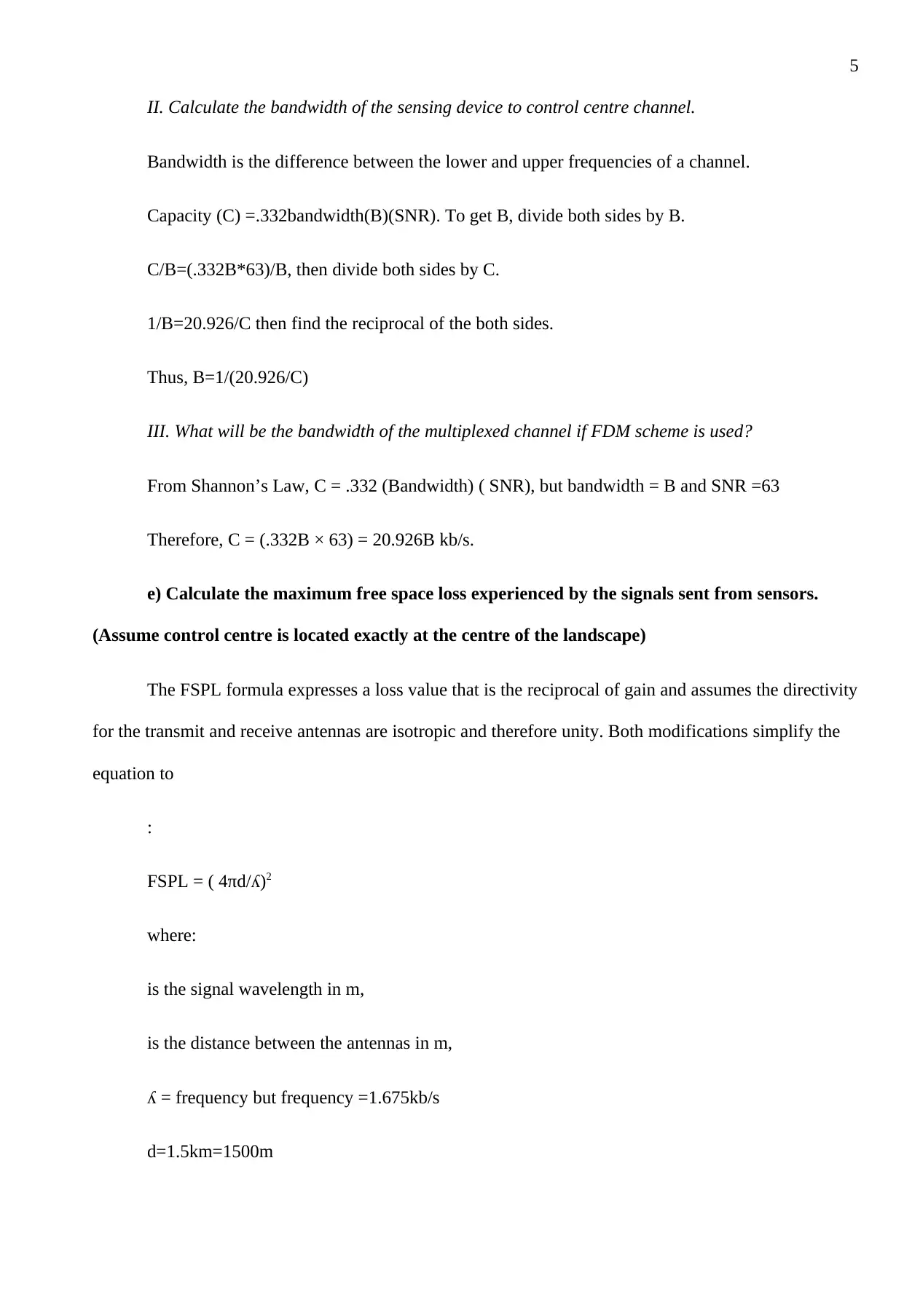
5
II. Calculate the bandwidth of the sensing device to control centre channel.
Bandwidth is the difference between the lower and upper frequencies of a channel.
Capacity (C) =.332bandwidth(B)(SNR). To get B, divide both sides by B.
C/B=(.332B*63)/B, then divide both sides by C.
1/B=20.926/C then find the reciprocal of the both sides.
Thus, B=1/(20.926/C)
III. What will be the bandwidth of the multiplexed channel if FDM scheme is used?
From Shannon’s Law, C = .332 (Bandwidth) ( SNR), but bandwidth = B and SNR =63
Therefore, C = (.332B × 63) = 20.926B kb/s.
e) Calculate the maximum free space loss experienced by the signals sent from sensors.
(Assume control centre is located exactly at the centre of the landscape)
The FSPL formula expresses a loss value that is the reciprocal of gain and assumes the directivity
for the transmit and receive antennas are isotropic and therefore unity. Both modifications simplify the
equation to
:
FSPL = ( 4πd/ʎ)2
where:
is the signal wavelength in m,
is the distance between the antennas in m,
ʎ = frequency but frequency =1.675kb/s
d=1.5km=1500m
II. Calculate the bandwidth of the sensing device to control centre channel.
Bandwidth is the difference between the lower and upper frequencies of a channel.
Capacity (C) =.332bandwidth(B)(SNR). To get B, divide both sides by B.
C/B=(.332B*63)/B, then divide both sides by C.
1/B=20.926/C then find the reciprocal of the both sides.
Thus, B=1/(20.926/C)
III. What will be the bandwidth of the multiplexed channel if FDM scheme is used?
From Shannon’s Law, C = .332 (Bandwidth) ( SNR), but bandwidth = B and SNR =63
Therefore, C = (.332B × 63) = 20.926B kb/s.
e) Calculate the maximum free space loss experienced by the signals sent from sensors.
(Assume control centre is located exactly at the centre of the landscape)
The FSPL formula expresses a loss value that is the reciprocal of gain and assumes the directivity
for the transmit and receive antennas are isotropic and therefore unity. Both modifications simplify the
equation to
:
FSPL = ( 4πd/ʎ)2
where:
is the signal wavelength in m,
is the distance between the antennas in m,
ʎ = frequency but frequency =1.675kb/s
d=1.5km=1500m

6
therefore, FSPL = (4*3.142/1.675) =7.503
f) Determine the required transmission signal strength if other impairments such as attenuation
and fading causes loss of 30% in signal power during the propagation from sensors to the control centre.
solution
The signal loss due to attenuation and fading is the same as the maximum free space loss
experienced by the signals sent from sensors.
This signal lost accounts for 30% of the total signal.
From the question ‘e’ above, the signal lost during the data transfer = 7.503.
Therefore, if 7.503 = 30%,
The total signal required = (7.503*100)/30 = 25.01 dBμV/m
g) With your general knowledge in agriculture sector and business suggest functionalities
for the cloud application to effectively use sensor data.
With the introduction of WSN in the agricultural and business sectors, there is an increase I the
amount of resources that are required for the efficiency in the operation of such devices. The need for
enough storage for the data collected from the fields. But should the agricultural or business sectors
involved be worried about the issue? No, they shouldn’t. This is due to the fact that there has been
development of new technologies that can handle that issue for them. The cloud computing for instance,
has evolved over the recent years and has merged to be one of the most sufficient and efficient
technologies that can be used to remotely store bulky and confidential data from different locations and
organizations for considerably fair prices Rao, (2012).
therefore, FSPL = (4*3.142/1.675) =7.503
f) Determine the required transmission signal strength if other impairments such as attenuation
and fading causes loss of 30% in signal power during the propagation from sensors to the control centre.
solution
The signal loss due to attenuation and fading is the same as the maximum free space loss
experienced by the signals sent from sensors.
This signal lost accounts for 30% of the total signal.
From the question ‘e’ above, the signal lost during the data transfer = 7.503.
Therefore, if 7.503 = 30%,
The total signal required = (7.503*100)/30 = 25.01 dBμV/m
g) With your general knowledge in agriculture sector and business suggest functionalities
for the cloud application to effectively use sensor data.
With the introduction of WSN in the agricultural and business sectors, there is an increase I the
amount of resources that are required for the efficiency in the operation of such devices. The need for
enough storage for the data collected from the fields. But should the agricultural or business sectors
involved be worried about the issue? No, they shouldn’t. This is due to the fact that there has been
development of new technologies that can handle that issue for them. The cloud computing for instance,
has evolved over the recent years and has merged to be one of the most sufficient and efficient
technologies that can be used to remotely store bulky and confidential data from different locations and
organizations for considerably fair prices Rao, (2012).
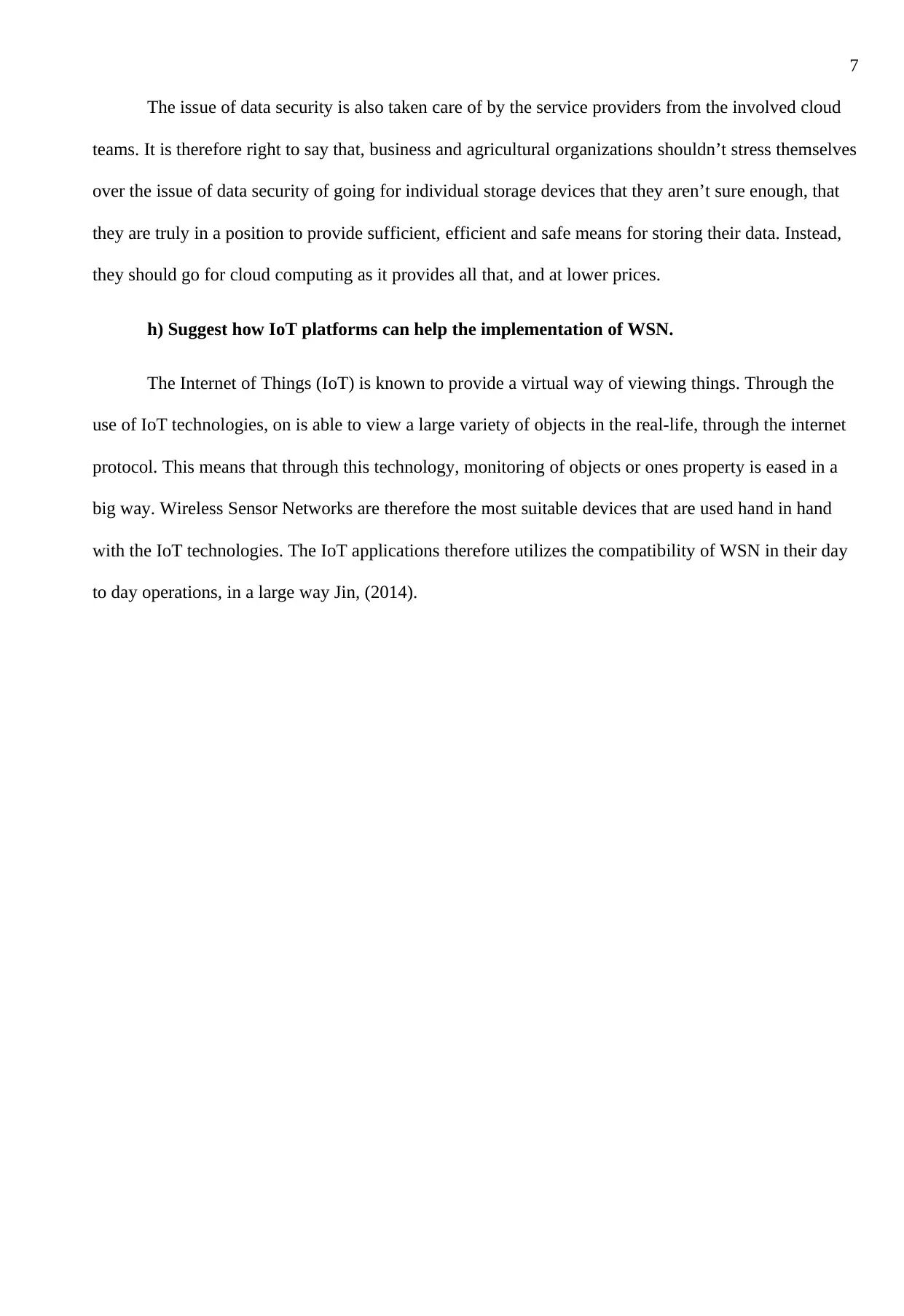
7
The issue of data security is also taken care of by the service providers from the involved cloud
teams. It is therefore right to say that, business and agricultural organizations shouldn’t stress themselves
over the issue of data security of going for individual storage devices that they aren’t sure enough, that
they are truly in a position to provide sufficient, efficient and safe means for storing their data. Instead,
they should go for cloud computing as it provides all that, and at lower prices.
h) Suggest how IoT platforms can help the implementation of WSN.
The Internet of Things (IoT) is known to provide a virtual way of viewing things. Through the
use of IoT technologies, on is able to view a large variety of objects in the real-life, through the internet
protocol. This means that through this technology, monitoring of objects or ones property is eased in a
big way. Wireless Sensor Networks are therefore the most suitable devices that are used hand in hand
with the IoT technologies. The IoT applications therefore utilizes the compatibility of WSN in their day
to day operations, in a large way Jin, (2014).
The issue of data security is also taken care of by the service providers from the involved cloud
teams. It is therefore right to say that, business and agricultural organizations shouldn’t stress themselves
over the issue of data security of going for individual storage devices that they aren’t sure enough, that
they are truly in a position to provide sufficient, efficient and safe means for storing their data. Instead,
they should go for cloud computing as it provides all that, and at lower prices.
h) Suggest how IoT platforms can help the implementation of WSN.
The Internet of Things (IoT) is known to provide a virtual way of viewing things. Through the
use of IoT technologies, on is able to view a large variety of objects in the real-life, through the internet
protocol. This means that through this technology, monitoring of objects or ones property is eased in a
big way. Wireless Sensor Networks are therefore the most suitable devices that are used hand in hand
with the IoT technologies. The IoT applications therefore utilizes the compatibility of WSN in their day
to day operations, in a large way Jin, (2014).
Paraphrase This Document
Need a fresh take? Get an instant paraphrase of this document with our AI Paraphraser
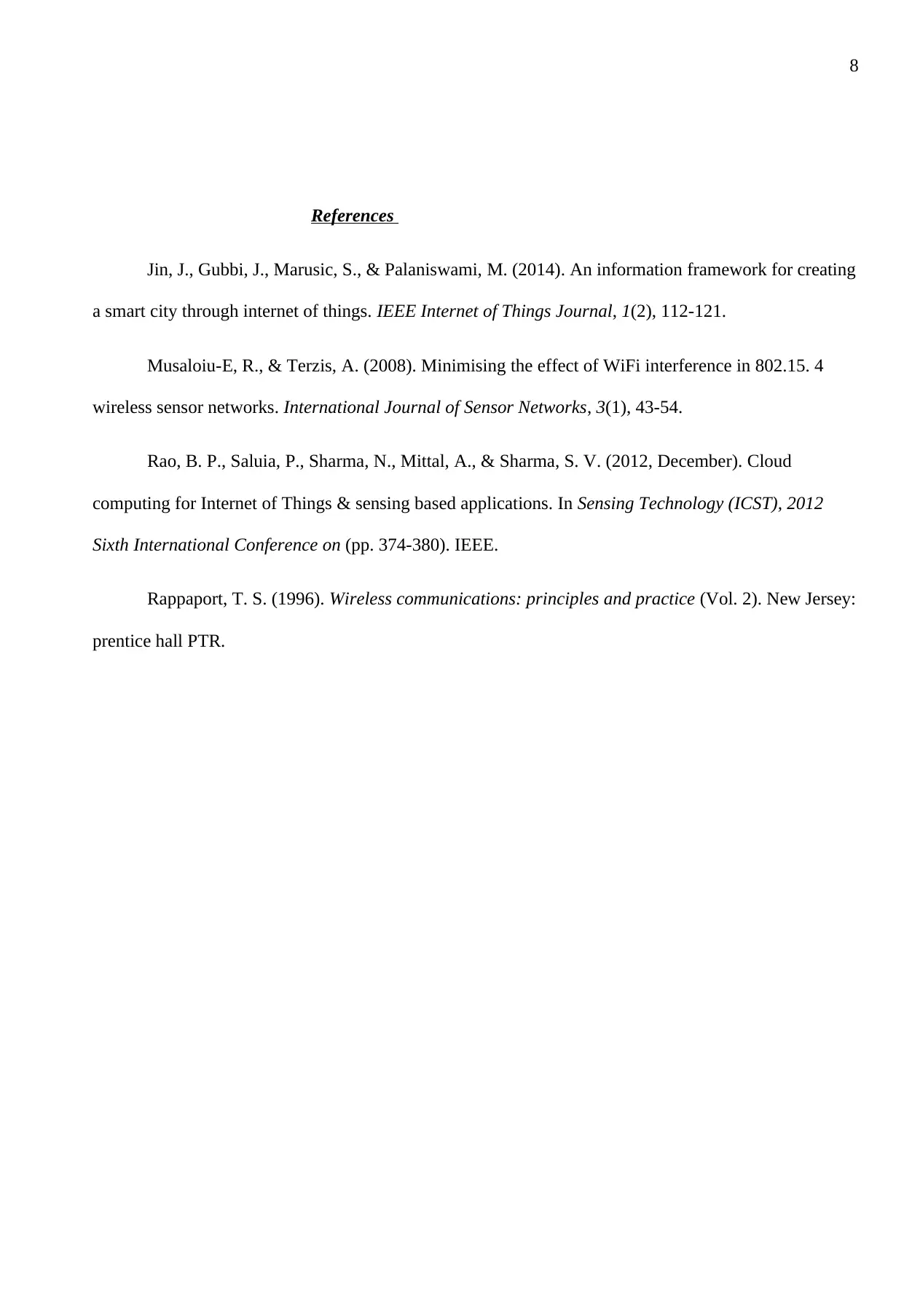
8
References
Jin, J., Gubbi, J., Marusic, S., & Palaniswami, M. (2014). An information framework for creating
a smart city through internet of things. IEEE Internet of Things Journal, 1(2), 112-121.
Musaloiu-E, R., & Terzis, A. (2008). Minimising the effect of WiFi interference in 802.15. 4
wireless sensor networks. International Journal of Sensor Networks, 3(1), 43-54.
Rao, B. P., Saluia, P., Sharma, N., Mittal, A., & Sharma, S. V. (2012, December). Cloud
computing for Internet of Things & sensing based applications. In Sensing Technology (ICST), 2012
Sixth International Conference on (pp. 374-380). IEEE.
Rappaport, T. S. (1996). Wireless communications: principles and practice (Vol. 2). New Jersey:
prentice hall PTR.
References
Jin, J., Gubbi, J., Marusic, S., & Palaniswami, M. (2014). An information framework for creating
a smart city through internet of things. IEEE Internet of Things Journal, 1(2), 112-121.
Musaloiu-E, R., & Terzis, A. (2008). Minimising the effect of WiFi interference in 802.15. 4
wireless sensor networks. International Journal of Sensor Networks, 3(1), 43-54.
Rao, B. P., Saluia, P., Sharma, N., Mittal, A., & Sharma, S. V. (2012, December). Cloud
computing for Internet of Things & sensing based applications. In Sensing Technology (ICST), 2012
Sixth International Conference on (pp. 374-380). IEEE.
Rappaport, T. S. (1996). Wireless communications: principles and practice (Vol. 2). New Jersey:
prentice hall PTR.

9
1 out of 9
Related Documents
Your All-in-One AI-Powered Toolkit for Academic Success.
+13062052269
info@desklib.com
Available 24*7 on WhatsApp / Email
![[object Object]](/_next/static/media/star-bottom.7253800d.svg)
Unlock your academic potential
© 2024 | Zucol Services PVT LTD | All rights reserved.



